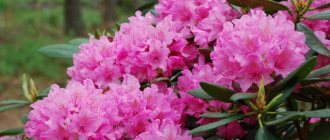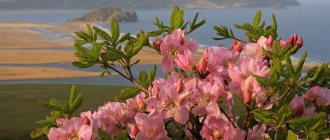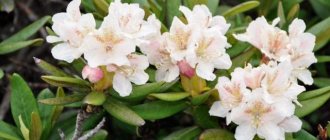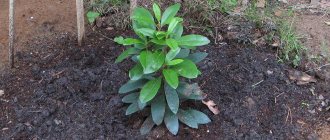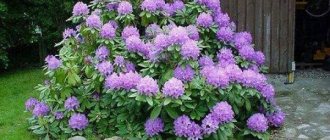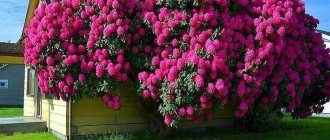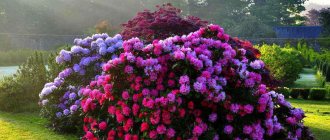One of the most exciting hobbies is growing rhododendrons from seeds. They grow extremely slowly in the first years. If you choose the right soil composition, they do not create any problems: the seeds germinate easily, amicably, and stably; seedlings do not get sick.
Rhododendron seeds look like tiny dust, a little smaller in some species, a little larger in others. They do not require stratification. It is necessary to pour acidic peat (preferably not too coarse) into a container with drainage holes and moisten it, the seeds are evenly scattered over the surface, carefully sprayed with a spray bottle so that they are not blown away. Arcs are placed on the container and covered with film, or a transparent removable high lid, if it is a mini-greenhouse. Next, for about two weeks, you should ventilate the crops daily for 30 minutes, and also spray as necessary. Shoots will appear. If they are too thick, they can be picked straight away, but this is usually not necessary. It is important to ensure that mold does not appear on the surface of the soil and to continue to ventilate the seedlings. When new shoots stop appearing, you should gradually increase the ventilation time, accustoming the rhododendrons to normal humidity. If the room is too dry, you can leave the film on or spray the seedlings daily.
Rhododendron seedlings in the correct substrate are not too afraid of waterlogging or drying out of the coma, but it is undesirable to allow either one or the other. If the watering schedule is incorrect, or if the air is too dry, they can be affected by spider mites - this is a clear sign of very poor living conditions. Rhododendrons do not like too hot sunlight; on a south-facing window, in the very sun, it is better to protect them with a sheet of thin paper.
I plant rhododendrons as they grow in separate cups. The composition of the soil is the same. You should very carefully accustom them to the street air, be sure to protect them from excess sunlight, especially during their first street “walks”, as well as after transplants. It is better if they are shaded from the south, including in winter and spring.
- Rhododendron Daurian
- Rhododendron golden
- Canadian rhododendron
- Rhododendron katevba
- Lapland rhododendron
- Rhododendron Ledeboura
- Rhododendron acuminate
- Rhododendron podelnikovy
- Rhododendron Fori
- Rhododendron Schlippenbach
Rhododendron Daurian
Rhododendron dauricum L.
Winter-hardy, moderately drought-resistant shrub, growing on rocky slopes under the canopy of coniferous trees. In snowy places it weathers out. [Z. I. Luchnik, T. N. Vstovskaya]
Grown according to the general scheme. In the second summer, the seedlings looked like this:
PC19 Dahurian rhododendron Rhododendron dauricum L.
For the third summer:
PC19 Daurian rhododendron for 3 years
Use in landscape design
Rhododendrons are compared to roses in their spectacular flowering. And not in vain, in the literal translation “Rhodon” is a rose, and “Dendron” is a tree. They are distinguished by decorative leaves and spectacular flowering. Due to the peculiarities of growing conditions, they are planted alone as a tapeworm or in the vicinity of other varieties. Also, combinations with plants that need acidified soil are possible.
- Some varietal low-growing spruce and pine trees.
- Hydrangea is tree-like and large-leaved (with constant monitoring of root growth). Rhododendrons and hydrangeas have a shallow root system; you need to make sure that their “vital interests” do not overlap.
- Heather.
- Erika.
Rhododendrons look spectacular against the background of conifers.
Canadian rhododendron
Rhododendron canadense (L.) Torr.
They were sown according to the general rule. The seedlings of all rhododendrons are incredibly small. To make them visible, we had to increase the green color saturation when processing the photo. Here is a photo to understand the scale:
PK131 Canadian rhododendron shoots from seeds
And here's a close-up of the same photo:
PC131 Seedlings of Canadian rhododendron close-up
They grow slowly. I drink it in 150 ml cups for a month or two, and transfer it to larger containers in the fall of the first year or in the spring of the second, after a good winter. The problem with wintering small seedlings is that they are squeezed out of the soil by frost and in the spring it is necessary to find and return all the “fugitives” to their place.
Seedling care
Cultivation enters the active stage, since at a room temperature of 20 degrees, the first shoots can be expected within a week. Experts say that the massive appearance of sprouts occurs after 2-3 weeks. Care consists of regular watering as needed, ventilation of the greenhouse and a good location. After 2 months, you can place the grown seedlings in a warmer place on a north or east window; if this is not possible, then try to shade the plant from direct sunlight.
Dive
The picking procedure is necessary, but it directly depends on the chosen variety, since some plants are ready for picking already in April, while others only by June. Therefore, carefully study the plant and, if necessary, pick. The mixture of the new container should also be acidic, but of greater concentration, so the components will remain the same: peat, compost and sand, but this time you need to take equal parts of them.
Rhododendron katevba
Rhododendron catawbiense Michx.
The seedlings were transplanted into larger bags in the fall of the first year, and after wintering they looked like this:
PC16 Rhododendron catawbiense Michx.
For the third summer:
PK16 Rhododendron katevba for 3 years
Rhododendron Schlippenbach - characteristic differences of the species
Rhododendrons are native to East Asia with its mild, warm and humid climate. On the territory of Russia, it grows only in the far south, in Primorye, taking root in the lower mountain belt of oak forests and their edges.
In the Primorsky Territory of Russia, Schlippenbach rhododendron is listed in the Red Book. The population of this crop is rapidly declining due to the harvest of the plant, as well as due to the degradation of the oak forests where it prefers to grow.
The perennial shrub belongs to the deciduous species of the Rhododendron genus of the Ericaceae family. It can have a powerful trunk and a height of up to 4 m only if it grows in forests. But most often the culture chooses dry rocky mountain slopes as a place of growth. There it has the appearance of an almost creeping shrub up to 0.5 m high. In gardens, the height of cultivated plants does not exceed 2 m.
Young rhododendrons have slightly pubescent brownish shoots. With age, they become smooth and acquire a beautiful gray color. Active growth begins with the arrival of the first warmth in April and until the beginning of summer the bush grows young shoots. By October it becomes lignified and ready for wintering. The bush branches most strongly if the main shoot stops developing. Then the plant can form up to a dozen second-order branches. The foliage is very beautiful, pinnately dissected, changing its green color to elegant crimson colors by autumn.
Features of flowering
Young rhododendrons begin their first flowering late, no earlier than 6-8 years after planting. But the buds themselves bloom very early, almost together with the leaves, and sometimes even before them. Flowering begins in the first ten days of May and lasts two weeks.
It is not for nothing that rhododendron is called the “Alpine rose”, because it blooms very beautifully. Schlippenbach's species is distinguished by the delicate pale pink color of its flowers, which bloom in several pieces at the tops of the shoots. They are quite large, up to 8 cm in diameter, with purple specks at the base of the petals and a pleasant aroma. Sometimes you can find white flowers in nature.
When grown as a garden crop, a problem that often arises is that it does not bloom. This is due to the fact that the shrub is vulnerable to frost - flower buds often die from returning spring frosts.
Lapland rhododendron
Rhododendron lapponicum (L.) Wahlenb.
Lapland rhododendron seeds close-up (1 ruler division - 1mm):
PK657 Lapland rhododendron seeds
Rhododendron shoots appear quite quickly, within a couple of weeks. They are very small, only with the help of very good photographic equipment can you take a frame in which they will be visible:
PK657 Lapland rhododendron shoots from seeds. The height of the shoots is 3 mm or less.
Necessary conditions for seed germination
Finally, the preparatory stage is over and sowing can begin .
Rhododendron seeds germinate only in light. carefully lay them out on the surface of the substrate or peat tablets, without covering them with soil . After sowing, I carefully moisten with a spray bottle, making sure that they do not float into the substrate or are washed off from the tablets.
After sowing, the main thing is to maintain constant humidity of the substrate and air so that the seeds do not dry out in any case. Therefore, sowing bowls can be placed in a purchased mini-greenhouse or a transparent cake box. Either cover a deep tray with bowls with glass or wrap it in cling film. To protect against room dryness, pour a little water or place damp sphagnum at the bottom of all improvised shelters.
seeds germinate at room temperature (18-20°), the first shoots usually appear after 7-10 days, the bulk - after 14-20 days. However, some types of rhododendrons may require longer germination - up to 1-1.5 months, depending on the freshness of the seeds.
Rhododendron Ledeboura
Rhododendron ledebourii Pojark.
A local Altai species, it is called here “maralnik”. It’s difficult to say why - maybe because it grows on steep cliffs, where only deer can climb?.. I can’t resist quoting from the book by Z. I. Luchnik describing the natural habitats of the Ledebur rhododendron:
In “Flora of the USSR”, rhododendron, which lives in the Altai Mountains, in the Western and Eastern Sayan Mountains, as well as in the northwestern part of Mongolia, is described as an independent species [ separated from Daurian rhododendron, my note ], distinguished by larger flowers and small elliptical evergreen leaves , while in the Dahurian rhododendron all leaves, with the exception of a few apical ones, fall off in the winter. The ecology of Rhododendron Ledebur is unique. It grows in both humid and arid regions, on open rocky mountain slopes, on rocky banks of mountain rivers and as undergrowth in pine and deciduous forests, rarely in spruce forests on large hummocks (Buryat Autonomous Soviet Socialist Republic); in the mountains it rises to the lower part of the alpine belt. Everywhere its habitats are associated with rocky soil or sandy loam deposits in mountain river valleys. In the vicinity of Gorno-Altaisk, surrounded by humid forests (with 705 mm of annual precipitation), rhododendron is found only on steep slopes among the forest. In the less humid and little snow region of Chemal (514 mm) in the valley of the river. Katun rhododendron Ledeboura grows in huge quantities along all southern rocky slopes. Higher along the river valley. Katun, in the arid region of Yaloman (232 mm), Ledebur rhododendron is found in extensive thickets along the northern slopes, overgrown with a low moss cover.
From this description it is clearly seen that this rhododendron is unlikely to be in danger of freezing. At the heights in the Yaloman region, the climate is as harsh and unattractive as one can imagine. It is paradoxical that the introduction of this species into culture is associated with numerous difficulties. For Rhododendron Ledebur, it is necessary to create the illusion of its native harsh places - rocky slopes with little snow in winter, covered with acidic peat.
I grow seedlings of this species, like others, in 100% acidic peat and, apart from the problem of squeezing them out of the ground in winter, I have not noticed any other difficulties, but my Ledebur rhododendrons are still too small.
A month after the emergence of shoots, I dive into cups. Seedlings grow somewhat faster than other species:
PC214 Seedlings of Rhododendron Ledebur - the first true leaf
By autumn, Ledebur rhododendron seedlings have reached quite a respectable 10-12 cm:
PC214 Rhododendron Ledebura in the fall of the first year
Growing rhododendrons from seeds
The simplest and most economical way to propagate tree and shrub species is to propagate them by sowing seeds.
Seedlings grown from seeds have a number of advantages compared to seedlings obtained vegetatively. They have a regular, well-developed and highly branched root system, tolerate transplants better and are more durable.
It has also been noted that tree and shrub species grown from seeds grow better, give the greatest decorative effect, and they produce slender, beautiful specimens with a symmetrically developed crown. Therefore, in all cases where it is possible to use seed propagation, it should be given preference.
When selecting an assortment for a small nursery of ornamental plants, I chose rhododendrons.
These plants stand out among others for their beauty and seem to many to be unearthly and mysterious, having accidentally found themselves in our climate. Gardener's Guide
Plant nurseries Garden supply stores Landscape design studios
It seemed so to me, until I decided to try growing them from seeds. I read a lot of information on the Internet. By that time I already had boxes of Kavtebinsky rhododendron seeds, and then I also bought Japanese rhododendron seeds from a passionate lover and already experienced rhododendron grower from the Moscow region - A.V. Sergeeva. They retain germination for up to 3 years.
And so in January I decided to start sowing. At the same time, I tried to strictly adhere to the technology for growing rhododendrons recommended by an experienced master. The seeds of these beauties are very small, and therefore they are sown superficially, without being embedded in the soil. To germinate, rhododendrons need a temperature of +25°C, lighting, regular spraying with soft water and daily ventilation of containers with crops to prevent the seeds from becoming moldy.
The first shoots from the seeds were so small that it was scary to take any action. But they had to be looked after. And I started making the first fertilizing with very weak fertilizer solutions.
Rhododendrons grow in acidic soils with a pH of 4.0-4.5, so seedlings should be fed with acidic fertilizers specifically designed for rhododendrons or azaleas. You can also feed it with Kemira-Lux complex mineral fertilizer.
Of course, it is very troublesome to maintain crops of such little ones in an apartment. But as soon as the opportunity arose, and this happened in April, they transferred the crops to an unheated greenhouse and there they planted the seedlings into small plastic pots with a volume of 0.3 liters. After picking and watering, the seedlings were placed in partial shade and covered with non-woven material to protect them from the sun.
The next important step was hardening, maintaining optimal soil moisture and mandatory ventilation of the greenhouse.
With the onset of stable positive air temperatures, we moved our babies to the nursery, placing pots in boxes, which we then placed on the ground. We covered them with non-woven material and tried to feed them with mineral fertilizers every ten days.
Bulletin board
Sale of kittens Sale of puppies Sale of horses
Over the summer I had to weed the plants in pots several times. But still, by autumn, our babies had grown noticeably - up to 10-15 cm, and then the difference in the types of rhododendrons became visible.
The Kavtebinsky rhododendron had shiny, leathery leaves, while the Japanese rhododendron had pubescent leaves and turned out to be slightly narrower than those of its relative.
In October, we had to think about where our rhododendron seedlings would spend the winter. I really wanted to hide them in a greenhouse or bring them home, in the hope that they would be better there. But the voice of reason suggested that the seedlings should spend the winter outside, getting used to our climate. Therefore, we had to dig them into the ground and cover them with pine needles, which allow air to pass through well and prevent our seedlings from getting wet. That's what we did.
And now spring has come, we are monitoring the plantings so as not to miss the arrival of stable warmth and bright sun, and in time to cover the buried seedlings from the sun’s rays, and we also want to know how they survived the first winter, which turned out to be not very favorable. We hope that everything will be fine, and in three to four years we will be able to see the first flowering of our long-awaited rhododendrons, grown from a small seed.
Natalya Gubanova, Seltso village, Tosnensky district, Leningrad region
26293
Tags: rhododendrons
Growing rhododendrons from seeds
Rhododendron acuminate
Rhododendron mucronulatum Turcz.
Another species close to Daurian rhododendron. Differs in less frost resistance than Ledebur's rhododendron, but is slightly less capricious in cultivation; Z.I. Luchnik grew well on rocky hills with a topping of acidic high-moor peat.
With rhododendron acuminate, I decided to try a new method of picking - in a common container, and not in separate cups. The advantages are obvious: saving space, less drying out. The disadvantages will appear when you need to plant seedlings with a delicate root system:
PK424 Rhododendron sprouts
Where to get rhododendron seeds and how to sow them correctly
ways to get seeds - from “collected yourself from a plant you liked” to “extracted from a botanical garden”, but most often the seeds can be found from amateur collectors and much less often - on general sale. One way or another, there are seeds.
Now the question arises when to sow . If it is possible to illuminate the seedlings (for example, with fluorescent lamps or special phytolamps), then it is better to sow rhododendrons in December or January . If you rely only on natural light , it is preferable to sow from mid-February to early March . With early sowing in December-January, rhododendron seedlings have time to go through two waves of growth before the fall, that is, they enter the first winter as “two-year-olds,” which is important.
sow and care drainage holes in them by melting them with a soldering iron, a heated nail, or drilling them, depending on the material of the sowing bowl.
Rhododendron Fori
Rhododendron fauriei Franch.
Grown according to the general scheme, in the second year it looked like this:
PC17 Rhododendron fauriei Franch. from seeds
For the third summer:
PC17 Rhododendron Fori for 3 years
Is it possible to grow azaleas at home and which varieties are best on the site?
You can plant shrubs both in open ground and in separate pots at home . It is important to choose the right variety. Azalea is a beautiful flower, but also very demanding in terms of soil, lighting and watering. Therefore, to grow a beautiful flowering bush at home, you will have to make a lot of effort.
Although there are many hybrids available today, they all originate from two main varieties:
- Indian azalea or Sims' azalea.
- Japanese azaleas with smaller but abundant blooms.
Traditionally, Indian azalea is grown at home, while Japanese shrubs are more suitable for planting in open ground.
When planting azaleas outdoors, pay close attention to choosing the right location. The flowering of the bush will depend on this.
Depending on the flowering time, varieties are divided into:
- early flowering (from December to January);
- mid-flowering (from February to March);
- late flowering (from March to April).
Popular varieties for home use:
- with white flowering - Elizabeth, Snowflake;
- with red flowers - Ilona, Florida;
- with raspberry buds - Cosmos, Orange Bowen.
Common varieties for planting in open ground:
- with white flowers - Adonis, Kermesina Alba;
- red buds - Toreador, Fridoline;
- crimson shade - Kermensina Rosa, Raimund.
You can learn how to grow azaleas on a trunk here, and read about the types of azaleas and their healing properties here.
Vegetative propagation
Green cuttings
This method is used for propagating deciduous rhododendrons. At the end of May - beginning of June, the green apical shoots are cut off and cut into cuttings five to ten centimeters long. Two leaves are left on them and placed in water or moisture-saturated soil.
When roots form on the shoots, they are buried in small greenhouses for rooting. For the winter, the cuttings are brought into the house and planted in a permanent place next spring.
Semi-lignified cuttings
Propagation of rhododendrons by semi-lignified cuttings is most common among gardeners. Such cuttings, unlike green ones, are already stronger and more mature. They are cut at the end of June.
The sequence of rooting of semi-lignified cuttings is as follows.
- We cut cuttings from five to eight centimeters long with two leaves.
- Cut the leaves in half.
- Make the top cut flat and half a centimeter above the leaf bud.
- The lower oblique cut is one centimeter below the last bud.
- On the lower part of the cutting we make short longitudinal grooves along the bark to the cambium for better rooting.
- Place the prepared cuttings overnight in a jar with a rooting stimulator solution.
- Then we transplant the cuttings into a mini-greenhouse.
We will plant it in a permanent place next spring.
We take care of the crops and wait for shoots
After the seeds are sown, they need to be watered. This must be done extremely carefully so as not to wash away the crops, therefore, when watering from a spray bottle, it must be kept away from the container, or you can use a syringe, watering the crops in droplets. If the seeds are sown on the surface of the snow, there is no need to water them - they will settle after the snow melts. The crops are covered with glass and placed on a well-lit windowsill, at temperatures up to +23°C. As long as the container is covered with glass, it is necessary to remove condensation to prevent excessive dampness, but at the same time, it is necessary to ensure that the surface of the soil with crops does not dry out.
As soon as the seeds begin to germinate, it is necessary to ventilate the seedlings, and when most of them have sprouted, the glass can be removed completely.
Seeds of different types of rhododendrons germinate in different ways: from one week (in Japanese rhododendron), to 2.5 weeks (in Smirnov, Pontic and Caucasian rhododendron), or up to 3.5 weeks in other species. In addition, in the same species, seed germination may occur unevenly, both in terms of germination time and in the number of seedlings.
Shoots

